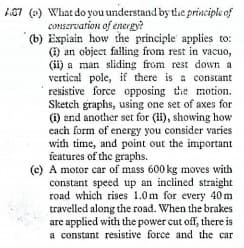What do you understand by the principle of conservation of energy? Expiain how the principle applies to: (i) an object falling from rest in vacuo, (ii) a man sliding from rest down a vertical pole, if there is a constant resistive force opposing the motion. Sketch graphs, using one set of axes for (i) and another set for (i), showing how cach form of energy you consider varies with time, and point out the important features of the graphs. A motor car of mass 600 kg moves with constant speed up an inclined straight road which rises 1.0m for every 40 m travelled along the road. When the brakes are applied with the power cut off, there is a constant resistive force and the car
What do you understand by the principle of conservation of energy? Expiain how the principle applies to: (i) an object falling from rest in vacuo, (ii) a man sliding from rest down a vertical pole, if there is a constant resistive force opposing the motion. Sketch graphs, using one set of axes for (i) and another set for (i), showing how cach form of energy you consider varies with time, and point out the important features of the graphs. A motor car of mass 600 kg moves with constant speed up an inclined straight road which rises 1.0m for every 40 m travelled along the road. When the brakes are applied with the power cut off, there is a constant resistive force and the car
Elements Of Electromagnetics
7th Edition
ISBN:9780190698614
Author:Sadiku, Matthew N. O.
Publisher:Sadiku, Matthew N. O.
ChapterMA: Math Assessment
Section: Chapter Questions
Problem 1.1MA
Related questions
Question

Transcribed Image Text:comes to rest from a speed of 72 kmh
in a distance of 60 m. By using the
principle of conservation of energy, cál-
culate the resistive force and the decelera-
tion of the car.

Transcribed Image Text:67 (e) What do you understand by tdhe principle of
conServation of energy?
(b) Expiain how the principle applies to:
(1) an object falling from rest in vacuo,
(ii) a man sliding from rest down a.
vertical pole, if there is a constant
resistive force opposing the motion.
Sketch graphs, using one set of axes for
(i) and another set for (i), showing how
each form of energy you consider varies
with time, and point out the important
features of the graphs.
(c) A motor car of mass 600 kg moves with
constant speed up an inclined straight
road which rises 1.0m for every 40m
travelled along the road. When the brakes
are applied with the power cut off, there is
a constant resistive force and the car
Expert Solution
This question has been solved!
Explore an expertly crafted, step-by-step solution for a thorough understanding of key concepts.
Step by step
Solved in 2 steps with 2 images

Knowledge Booster
Learn more about
Need a deep-dive on the concept behind this application? Look no further. Learn more about this topic, mechanical-engineering and related others by exploring similar questions and additional content below.Recommended textbooks for you

Elements Of Electromagnetics
Mechanical Engineering
ISBN:
9780190698614
Author:
Sadiku, Matthew N. O.
Publisher:
Oxford University Press

Mechanics of Materials (10th Edition)
Mechanical Engineering
ISBN:
9780134319650
Author:
Russell C. Hibbeler
Publisher:
PEARSON

Thermodynamics: An Engineering Approach
Mechanical Engineering
ISBN:
9781259822674
Author:
Yunus A. Cengel Dr., Michael A. Boles
Publisher:
McGraw-Hill Education

Elements Of Electromagnetics
Mechanical Engineering
ISBN:
9780190698614
Author:
Sadiku, Matthew N. O.
Publisher:
Oxford University Press

Mechanics of Materials (10th Edition)
Mechanical Engineering
ISBN:
9780134319650
Author:
Russell C. Hibbeler
Publisher:
PEARSON

Thermodynamics: An Engineering Approach
Mechanical Engineering
ISBN:
9781259822674
Author:
Yunus A. Cengel Dr., Michael A. Boles
Publisher:
McGraw-Hill Education

Control Systems Engineering
Mechanical Engineering
ISBN:
9781118170519
Author:
Norman S. Nise
Publisher:
WILEY

Mechanics of Materials (MindTap Course List)
Mechanical Engineering
ISBN:
9781337093347
Author:
Barry J. Goodno, James M. Gere
Publisher:
Cengage Learning

Engineering Mechanics: Statics
Mechanical Engineering
ISBN:
9781118807330
Author:
James L. Meriam, L. G. Kraige, J. N. Bolton
Publisher:
WILEY